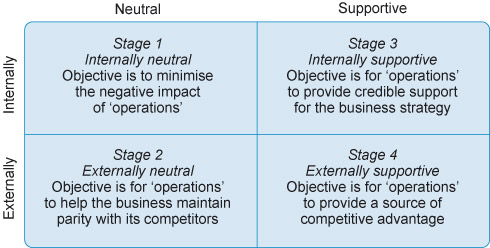4.1 The Hayes and Wheelwright four-stage model
One framework that helps to address these questions is the four-stage model of operations strategy by Hayes and Wheelwright (1984).

At the lowest levels of capability (Stage 1) the operation is seen as holding the organisation back. This is because the operation regularly underperforms, relative to its market requirements, and/or regularly makes mistakes that can deliver low quality product or service to the customer at tremendous cost of loss of reputation and rework.
A high proportion of operations are probably at Stage 2: they are striving to adopt best practice in their industry and are usually as good as their competitors at serving their market. These operations are good enough to help implement the organisation’s strategy but the operation itself does not convey any competitive advantage.
At Stage 3 the operation offers the best capabilities in the sector and so the competitive strategy can be linked to operations. The organisation can exploit the operations’ capabilities to offer better prices, differentiated products, faster deliveries or greater flexibility to maximise returns and increase market share.
Very few organisations ever operate at the levels described in Stage 4 of the model, where operations convey such a competitive advantage through their performance and capability that the entire organisation strategy can be built around the operation. In these situations the market expectations of what can be achieved are changed by the operations performance.
